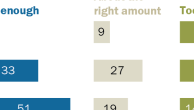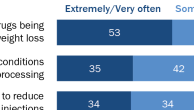
For many Americans, opinions on end-of-life treatment issues are closely linked with views on aging and quality-of-life issues. A 2009 Pew Research report illustrates the sometimes surprising ways in which society’s expectations of aging do not always match up with the experiences of older adults.15 The new Pew Research survey examines generational differences in people’s evaluations of their personal lives and explores public attitudes about what it means to have a good quality of life in older age.
Age, Life Cycle and Evaluations of Personal Life
While 81% of U.S. adults, including 76% of people ages 75 and older, say they are satisfied with their lives today, there are strong age differences when it comes to forward- and backward-looking evaluations.
Older adults are considerably less optimistic about the future. Fully 71% of those under age 50 expect their lives to be better in 10 years than they are today, as do 46% of those ages 50-64. By contrast, only about a fifth of adults ages 75 and older (19%) expect their lives to be better in the future than they are today.
By the same token, older adults are more inclined to see their current lives less positively than their past. About two-thirds of adults ages 18-49 say their lives today are better than they were 10 years ago. But the share of adults who share this perspective drops with age. At the other end of the spectrum, just three-in-ten adults ages 75 and older consider their lives today to be better than they were 10 years ago.

But when it comes to evaluations of their lives today, strong majorities of all age groups say they are satisfied with their lives overall.
The Pew Research survey also asked respondents to evaluate a number of specific life domains, including financial status, personal health and social relationships. Differences by age in these evaluations are particularly strong in just one domain — health status.
There are sizable differences by age in personal health. For instance, a third of adults under age 50 say their health is excellent, but about half as many adults ages 65 and older (16%) say the same.
By comparison, evaluations of social relationships are more modestly related to age. There are no or only modest differences among age groups when it comes to rating the number of friends in their lives. Overall, 36% of U.S. adults consider the number of friends they have to be excellent.
Of course, many younger adults have not yet had children. But, among those rating the relationship with their children, most tend to give it high marks; 64% of adults ages 18-49 say they have an excellent relationship with their children. Middle-aged and older adults also tend to see their relationship with their children, or now adult children, in positive terms. Roughly half of those ages 75 and older say their relationship with their children is excellent (47%). A roughly similar (i.e., not statistically different) share of adults age 50-64 and 65-74 also say their relationship with their children is excellent (54% and 55%, respectively).

Marital status tends to vary with the adult life cycle, but a majority of those who are married —whether older or younger — tend to say their relationship with their spouse is excellent. Overall, about six-in-ten married adults say their spousal relationship is excellent, 32% say it is good, and only 7% say their relationship with their marriage partner is either fair or poor.
Americans’ ratings of their personal financial situation are not strongly associated with age; 17% of adults ages 75 and older consider their personal financial situation to be excellent, as do 11% of adults ages 18-49 and 13% of those ages 50-64.
What Contributes to a Good Quality of Life?

The Pew Research survey asked respondents for their perceptions of the characteristics and functions that influence quality of life in older age. About half of adults (49%) say being able to talk or communicate is extremely important for a good quality of life in older age. Similar shares of adults say that being able to feed oneself (45%), getting enjoyment out of life (44%) and living without severe, long-lasting pain (43%) are extremely important for a good quality of life. Fewer respondents rate other characteristics as extremely important, including having long-term memory about important people and experiences (37%), feeling what one does is worthwhile (37%), being able to dress oneself (36%) and having short-term memory for events that happened today (30%).

The older generation differs somewhat in its assessments of what contributes to a good quality of life, perhaps related to the higher likelihood that older adults have personal experience with some of these issues in their everyday lives. Older adults, especially those ages 75 and older, are less inclined than younger generations, especially those under age 50, to rate all but one of these characteristics as extremely important for a good quality of life. (The exception is being able to dress oneself; roughly a third of all age groups see this as extremely important for a good quality of life.) However, when it comes to the relative order of these ratings, all age groups rate being able to talk or communicate with others higher than the other characteristics considered.
Gender differences also are apparent on some of these ratings. Women are more inclined than men to say that being able to talk or communicate with others is extremely important for a good quality of life in older age (51% vs. 46%). However, this difference is concentrated among adults ages 50 and older; about half of both men (51%) and women (54%) ages 18-49 consider being able to communicate with others extremely important for a good quality of life.

More women than men also say that living without severe, long-lasting pain is extremely important for a good quality of life in older age (46% vs. 38%).
There also are modest gender differences in the importance of getting enjoyment out of life and feeling that what one does in life is worthwhile. Women are more inclined than men to consider each characteristic extremely important for a good quality of life in older age.
However, men and women are about equally likely to see each of the following characteristics as extremely important for a good quality of life in older age: being able to feed and dress oneself, having long-term memory about important people and experiences in one’s life, and having short-term memory about events happening on any given day.

Views about some of the characteristics necessary for a good quality of life in older age are modestly related to views about end-of-life treatment. For instance, those who consider the ability to communicate to be important for a good quality of life are more inclined to say there are circumstances in which a patient should be allowed to die compared with those who consider being able to talk or communicate less important (70% vs. 53%). Ratings for several other characteristics are not related to general views about end-of-life treatment, including the importance of being able to feed oneself; living without severe, long-lasting pain; and getting enjoyment out of life.
Perceptions of what contributes to a good quality of life in older age tend to be more closely related to opinions about doctor-assisted suicide. For example, those who consider being able to communicate with others or living without severe long-term pain to be extremely important for a good quality of life are more inclined to approve of laws to allow doctor-assisted suicide compared with those who see such characteristics as less critical to a good quality of life.




